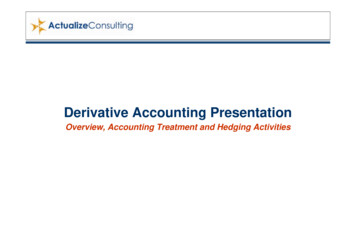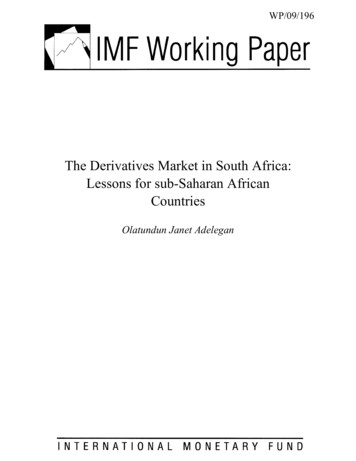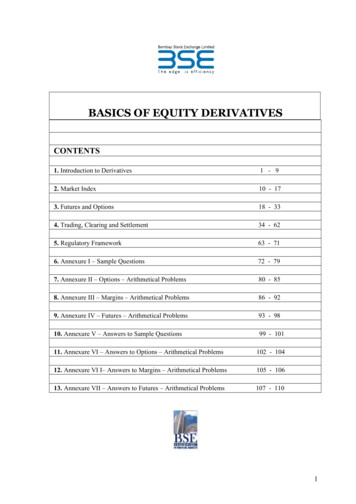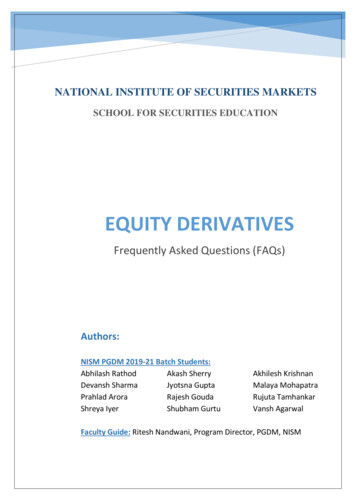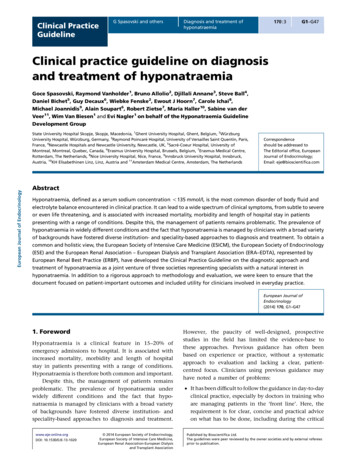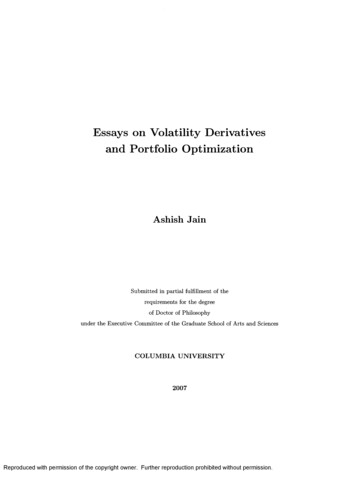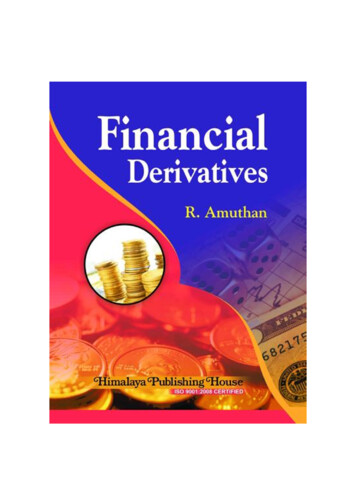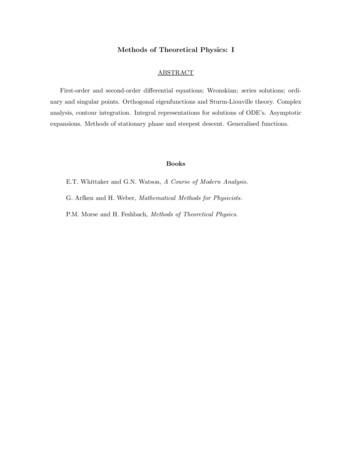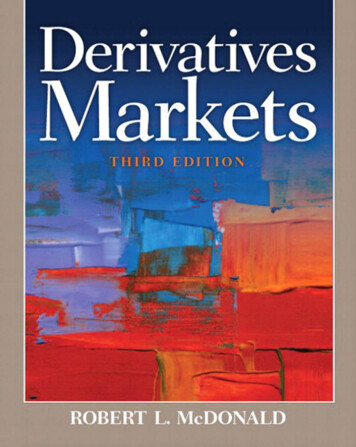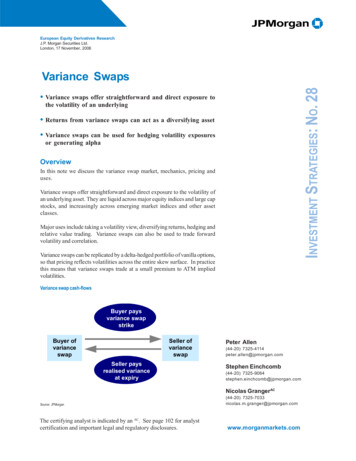
Transcription
European Equity Derivatives ResearchJ.P. Morgan Securities Ltd.London, 17 November, 2006INVESTMENT STRATEGIES: NO. 28Variance Swaps Variance swaps offer straightforward and direct exposure tothe volatility of an underlying Returns from variance swaps can act as a diversifying asset Variance swaps can be used for hedging volatility exposuresor generating alphaOverviewIn this note we discuss the variance swap market, mechanics, pricing anduses.Variance swaps offer straightforward and direct exposure to the volatility ofan underlying asset. They are liquid across major equity indices and large capstocks, and increasingly across emerging market indices and other assetclasses.Major uses include taking a volatility view, diversifying returns, hedging andrelative value trading. Variance swaps can also be used to trade forwardvolatility and correlation.Variance swaps can be replicated by a delta-hedged portfolio of vanilla options,so that pricing reflects volatilities across the entire skew surface. In practicethis means that variance swaps trade at a small premium to ATM impliedvolatilities.Variance swap cash-flowsBuyer paysvariance swapstrikeBuyer ofvarianceswapSeller ofvarianceswapSeller paysrealised varianceat expiryPeter Allen(44-20) 7325-4114peter.allen@jpmorgan.comStephen Einchcomb(44-20) 7325-9064stephen.einchcomb@jpmorgan.comNicolas GrangerACSource: JPMorganThe certifying analyst is indicated by an AC. See page 102 for analystcertification and important legal and regulatory disclosures.(44-20) arkets.com
Peter Allen(44-20) 7325-4114Stephen Einchcomb(44-20) 7325-9064Nicolas Granger(44-20) 7325-7033European Equity Derivatives Strategy17 November 2006Table of ContentsPart 1: Variance Swap Mechanics. 81.1: Realised volatility. 81.2: The variance swap contract . 111.3: Vega notional and variance notional . 121.4: Variance swap convexity. 131.5: Variance swap example – accruing realised volatility. 141.6: Variance swap mark-to-market . 151.7: Forward variance. 171.8: Variance swap contract specifications . 191.9: Example Variance Swap Term Sheet . 22Part 2: The Variance Swap Market . 242.1: Market development. 242.2: Historical prices . 262.3: Variance swaps and option volatilities . 282.4: Pricing rules of thumb . 302.5: What drives variance swap levels? . 332.6: The volatility risk premium. 342.7: Variance swaps as predictor of future volatility. 362.8: Is variance swap convexity fairly priced?. 382.9: Variance term structure. 41Part 3: Uses of Variance Swaps . 443.1: Exploiting a volatility view. 453.2: Specific hedging purposes . 463.3: Rolling short variance. 473.4: Diversification . 503.5: Index variance spreads . 513.6: Relative value single-stock volatility. 543.7: Variance dispersion and correlation trading. 563.8: Forward variance and volatility spikes . 583.9: Trading the variance swap term structure. 643.10: Skew and convexity trades . 663.11: Cross asset class trades: trading equity volatility against credit. 68Part 4: Replication and Hedging . 724.1: Delta hedging and dollar gamma . 734.2: Theta - the cost of gamma . 764.3: Options path-dependency: can volatility be captured by delta-hedging? . 774.4: From options to variance swaps . 794.5: Variance swap replication in one page . 814.6: Sensitivity to skew and convexity. 824.7: Variance swap Greeks . 844.8: Setting up a replicating portfolio. 874.9: Replication and hedging in practice . 894.10: Effects of variance swap hedging . 904.11: Why not volatility swaps? . 92Part 5: Future developments . 94References . 982
European Equity Derivatives Strategy17 November 2006Peter Allen(44-20) 7325-4114Stephen Einchcomb(44-20) 7325-9064Nicolas Granger(44-20) 7325-7033IntroductionIntroductionVariance swaps are instruments which offer investors straightforward and direct exposure to the volatility of anunderlying asset such as a stock or index. They are swap contracts where the parties agree to exchange a pre-agreedvariance level for the actual amount of variance realised over a period. Variance swaps offer investors a means of achievingdirect exposure to realised variance without the path-dependency issues associated with delta-hedged options.Buying a variance swap is like being long volatility at the strike level; if the market delivers more than implied by the strikeof the option, you are in profit, and if the market delivers less, you are in loss. Similarly, selling a variance swap is likebeing short volatility. However variance swaps are convex in volatility: a long position profits more from an increase involatility than it loses from a corresponding decrease. For this reason variance swaps normally trade above ATM volatility.Figure 1 : Variance swap payoffs are convex in volatilityFigure 2 : Euro Stoxx 50 implied and realised variance levelsp/l for 100K vega notional, variance strike of 20Euro Stoxx variance2,000,000variance swap p/l1,500,00025%3M Implied Variance20%3M RealisedRealisedVolatilityVariance3Mpayout linear in 5Apr-06Oct-06realised volatilitySource : JPMorganSource : JPMorganMarket developmentVariance swap contracts were first mentioned in the 1990’s, but like vanilla options only really took off following thedevelopment of robust pricing models through replication arguments. The directness of the exposure to volatility and therelative ease of replication through a static portfolio of options make variance swaps attractive instruments for investors andmarket-makers alike.The variance swap market has grown steadily in recent years, driven by investor demand to take direct volatility exposurewithout the cost and complexity of managing and delta-hedging a vanilla options position. Although it is possible toachieve variance swap payoffs using a portfolio of options, the variance swap contract offers a convenient package bundledwith the necessary delta-hedging, offering investors a simple and direct exposure to volatility, without any of the pathdependency issues associated with delta-hedging an option.Variance swaps were initially developed on index underlyings. In Europe, variance swaps on the Euro Stoxx 50 index areby far the most liquid, but DAX and FTSE are also frequently traded. Variance swaps are also tradable on the more liquidstock underlyings – especially Euro Stoxx 50 constituents, allowing for the construction of variance dispersion trades.Variance swaps are tradable on a range of indices across developed markets and increasingly also on developing markets.Bid/offer spreads have come in significantly over recent years and in Europe they are now typically in the region of 0.5vegas for indices and 1–2 vegas for single-stocks – although the latter vary according to liquidity factors. We expectspreads to come in further in future as liquidity continues to improve. Spreads for indices in the US and Japan are similarwith single stock bid/offers in the 2 – 2.5 vegas range. Spreads are naturally higher in emerging markets although these tooare becoming more liquid. With volatilities often much higher and less stable than in developed markets, emerging marketvariance can offer interesting opportunities.3
Peter Allen(44-20) 7325-4114Stephen Einchcomb(44-20) 7325-9064Nicolas Granger(44-20) 7325-7033European Equity Derivatives Strategy17 November 2006IntroductionThe most liquid variance swap maturities are generally from 3 months to around 2 years, although indices and more liquidstocks have variance swaps trading out to 3 or even 5 years and beyond. The most liquid maturities generally coincide withthe quarterly options expiry dates, meaning that they can be efficiently hedged with exchange-traded options of the samematurity. Good liquidity is also seen in the front 3 months for short-dated index variance. The VIX, VSTOXX and VDAXindices represent the theoretical prices of 1-month variance swaps on the S&P500, Euro Stoxx and DAX indicesrespectively, and are calculated by the exchanges from listed option prices, interpolating to get 1-month maturity. Thesevolatility indices are widely used as benchmark measures of equity market risk, even though they are only short-datedmeasures and are not directly tradable.Uses of variance swapsIncreasingly, investors have come to view volatility itself as an asset class, one that can diversify investment returns orhedge unwelcome investment scenarios. For example, volatility typically rises in a bear market, so holding a long volatilityposition (e.g. being long variance swaps) can help to hedge an equity portfolio. However, as with any asset, the path toriches is to buy when cheap and sell when expensive. And here investors can look to exploit the mean-reverting nature ofvolatility to add alpha to portfolios. For example, systematically selling volatility has historically been profitable, withreturns akin to selling credit protection.Variance swaps can be traded outright or spread against other products to create a wide variety of exposures. Below we listsome common uses.4 Exploiting a volatility view: Variance swaps are ideal for taking a direct view on the volatility of an underlyingwithout the path-dependency issues of a delta-hedged option. Specific hedging purposes: Variance swaps can be used for macro-hedging and also for hedging specificvolatility exposures, such as that resulting from structured products or life assurance policies. Rolling short variance: Short variance swaps can be used to capture the observed equity index volatility riskpremium. Rolling short index variance is an attractive systematic volatility strategy from a risk-return perspective. Diversification: Volatility can be thought of as an asset class in its own right, and as such can act to diversifyreturns within a portfolio. Index variance spreads: Variance swaps can be used to trade the spread of volatilities between two indices. Suchtrades can be thought of as either relative value volatility trades or as ‘volatility-beta’ trades aiming to profit from aspread of volatilities widening as volatility increases. Relative value single-stock volatility: Use volatility pairs, or cross-sectional regression volatility models to findrich/cheap single-stock volatilities Variance dispersion and correlation trading: Trading variance swaps on an index against variance swaps on itsconstituents provides exposure to equity correlation. Forward variance and volatility spikes: Long forward volatility can avoid potentially negative carry at the costof slide down the term structure, and can be a useful way of positioning for volatility spikes. Trading the variance term structure: Variance swaps can be used to trade the shape of the variance termstructure, analogous to the use of spreads and butterflies in fixed income to trade the shape of the yield curve. Skew and convexity trades: Variance swaps are long skew and convexity. Trading variance against (deltahedged) vanilla options provides interesting exposures to skew and/or convexity. Cross asset class trades: Equity Volatility and credit spreads are correlated, both being measures of corporaterisk. Variance swaps are useful instruments in debt/equity trades, either at the index or single name level.
Peter Allen(44-20) 7325-4114Stephen Einchcomb(44-20) 7325-9064Nicolas Granger(44-20) 7325-7033European Equity Derivatives Strategy17 November 2006IntroductionOutline of the documentPart 1: Variance Swap MechanicsWe consider the mechanics of variance swaps. We begin by defining realised volatility and consider some of itscommonly observed properties. We go on to define a variance swap, including a sample term sheet and specifications, andlook at the different measures of notional: vega and variance notionals. Variance swap mark-to-markets are easilycalculated, since variance is additive. This leads to the simple valuation of forward-starting variance swaps.Part 2: The Variance Swap MarketWe look at the variance swap market development, the pricing of variance swaps (including rules of thumb) and varianceswap drivers. Variance swap strikes are well correlated with standard Black-Scholes implied volatility derived from optionsprices. This should not be surprising, as both can be interpreted as market estimates of future volatility. Variance swapstrade slightly above ATM volatility levels, essentially due to the fact that variance swaps are long convexity (or volatility ofvolatility).Realised volatility and risk-aversion are major drivers of variance swap levels, with structured product flows impactingthe long end of the maturity curve. Short-dated variance swaps tend to do a relatively good job of predicting futurerealised volatility, at least better than using previous realised.Part 3: Uses of Variance SwapsWe discuss the uses of variance swaps, ranging from simple expressions of a volatility view, to relative value volatilitytrades, to more complex trades using variance to trade correlation, skew, convexity etc. One important use of varianceswaps, at least at the index level, is to exploit the volatility risk premium by systematically rolling a short variance swapposition. The volatility risk premium reflects the observed tendency of implied volatility to trade above realised volatility.Even though returns from a short variance or volatility position have more downside than upside risk, historically investorshave been more than compensated for this risk. Such strategies are now being incorporated into structured products such asJPMorgan’s Yield Alpha product.Part 4: Replication and HedgingPart 4 is more technical in nature. We outline the mechanism whereby a variance swap can be replicated by a portfolioof options. The main drawback of a delta-hedged option as a vehicle for trading volatility is that the dollar-gamma, whichcharacterises the exposure to realised volatility, is path dependent. It is possible to remove this path dependency bytrading a carefully chosen portfolio of options of different strikes. A variance swap consists of just this portfolio, bundledup with the necessary delta-hedging to give direct exposure to realised volatility. We give a concrete example of such aportfolio and consider some practical issues arising from variance swap hedging.In particular we discuss the potential impact of variance swap hedging on the underlying market, driven by the need ofreplicating option portfolios to be delta-hedged on the close (unlike other options). Depending on market positioning, suchhedging activity may exacerbate large moves into the close, potentially adding to market volatility. Hedging flows, andanticipation thereof, have been much talked about, although in an efficient market such flows should be propagated backthroughout the trading day.Part 5: Future DevelopmentsWe discuss 3rd generation variance swap products and future developments. Commonly watched volatility indicessuch as VIX and VSTOXX are in fact calculated as variance swap strikes, and futures exchanges have listed futures onthese indices. As yet there is no official variance swap fixing mirroring deposit or swap rate fixings. Conditionalvariance swaps have also increased in liquidity, and variance swaps on other asset classes are starting to be traded. Weexpect variance swap markets to continue to gain liquidity, fuelled by investor demand to trade pure volatility and by thedesire of investment banks to recycle their exotic and structured product risks.5
Peter Allen(44-20) 7325-4114Stephen Einchcomb(44-20) 7325-9064Nicolas Granger(44-20) 7325-70336European Equity Derivatives Strategy17 November 2006
1.11.21.31.41.51.61.71.81.9Realised volatilityThe variance swap contractVega notional and variance notionalVariance swap convexityVariance swap exampleVariance swap mark-to-marketForward varianceVariance swap contract specificationsExample variance swap term sheetPart 1: Variance Swap Mechanics1. Variance Swap Mechanics77
European Equity Derivatives Strategy17 November 2006Peter Allen(44-20) 7325-4114Stephen Einchcomb(44-20) 7325-9064Nicolas Granger(44-20) 7325-7033Part 1: Variance Swap MechanicsPart 1: Variance Swap MechanicsVariance swaps are instruments which offer investors straightforward and direct exposure to the volatility of anunderlying asset such as a stock or index. They are swap contracts where the parties agree to exchange a pre-agreedvariance level for the actual amount of variance realised over a period (variance is the square of volatility). Variance swapsoffer investors a means of achieving direct exposure to realised variance without the path-dependency issues associated withdelta-hedged options.Before discussing the mechanics of the variance swap contract we begin by defining the notion of realised volatility, andlook at some of its characteristics. We then define a variance swap and describe some common conventions such as themeans of expressing trade notionals. A variance swap pays out linearly in terms of the realised variance, but whenconsidered in terms of volatility (as it more commonly is) the payout is convex. We give a concrete example of a varianceswap trade to illustrate how the p/l from realised variance accrues over time. This naturally leads into a discussion of howvariance swaps are marked-to-market, through changes both to implied and realised variance. The linearity of variancewhich makes marking-to-market so straightforward also allows us to construct exposure to forward variance, throughforward starting variance swaps which offer an interesting alternative to the usual spot variance exposure. Finally weconsider some technicalities associated with variance swap contracts, such as the treatment of dividends and M&A events,and conclude Part 1 by giving an example of a variance swap term sheet.1.1: Realised volatilityVolatility measures the variability of returns of an underlying asset and in some sense provides a measure of the risk ofholding that underlying. In this note we are concerned with the volatility of equities and equity indices, although much ofthe discussion could apply to the volatility of other underlying assets such as credit, fixed-income, FX and commodities.Figure 3 shows the history of realised volatility on the Dow Jones Industrial Average over the last 100 years. Periods ofhigher volatility can be observed, e.g. in the early 1930’s as a result of the Great Depression, and to a lesser extent around2000 with the build-up and unwind of the dot-com bubble. Also noticeable is the effect of the 1987 crash, mostly due to anexceptionally large single day move, as well as numerous smaller volatility spikes.Figure 3 : Long term history of realised volatility3-month realised volatility (Dow Jones Industrial 019501960197019801990Source: JPMorganThe following are some of the commonly observed properties of (equity market) volatility:8 Volatility tends to be anti-correlated with the underlying over short time periods (Figure 4) Volatility can increase suddenly in ‘spikes’ Volatility can be observed to experience different regimes (Figure 5) Volatility tends to be mean reverting (within regimes)2000
European Equity Derivatives Strategy17 November 2006Peter Allen(44-20) 7325-4114Stephen Einchcomb(44-20) 7325-9064Nicolas Granger(44-20) 7325-7033Part 1: Variance Swap MechanicsThis list suggests some of the reasons why investors may wish to trade volatility: as a partial hedge against the underlying –especially for a volatility spike caused by a sudden market sell-off; as a diversifying asset class; to take a macro view e.g.for a potential change in volatility regime; or to trade a spread of volatility between related instruments.Figure 4 : in the short term volatility is anti-correlated with index levelEuro Stoxx 50 realised volatilityindex level Sep-06Source : JPMorgan50%40%370030%39001m realised volatility (lhs)index level (inverted, rhs)realised volatility3600380010%Figure 5 : 20 years of Euro Stoxx realised volatility: the index hasexperienced both high and low volatility regimesEuro Stox x 50 3m realised v 005Source : JPMorganMeasuring realised volatility and varianceRealised (or historical) volatility can be measured in a variety of ways. One of the simplest measures is the annualisedstandard deviation of daily (log) returns of an underlying, calculated from a data set spanning some fixed period of time –for example 1-month historical volatility is calculated as the annualised standard deviation of daily returns occurring in onemonth. This type of measure has the advantage of being very easy to understand and calculate and it is this which we usedthroughout this note.One issue with using this fixed time-period volatility is that the realised volatility calculated in this way can suddenly dropas a large magnitude return falls out of the window of observation. Other, more sophisticated, measures of realisedvolatility exist, which seek to alleviate this problem and provide a potentially better means of forecasting future volatility –for example by giving more weight to recent returns (exponentially weighted measures) and/or attempting to model themean-reverting and regime changing nature of volatility (GARCH models). See “Options, Futures and Other Derivatives”,J. Hull, for further details.Volatility can also be calculated using returns of various frequencies (weekly, daily, intra-day returns etc). If the returns aretruly independent, then, over a long enough time-frame, the realised volatility should be independent of the frequency of thereturns used to calculate it. However, in practice, volatility is usually calculated using daily close-to-close returns. This isalmost always the type of volatility which dictates the payoff of a variance swap contract.Volatility is usually quoted as an annualised volatility and expressed as a percentage. The annualised volatility representsthe expected annual standard deviation in distribution of the underlying, assuming returns are independent. To move fromthe standard deviation of daily log returns to annualised volatility, simply multiply by the square-root of the number oftrading days in the year, usually taken to be 252. Note that since the square-root of 252 is about 16, a volatility of 16%equates to a standard deviation of daily moves of around 1%.Volatility can also be defined by an RMS (root-mean-squared) measure, which is like a standard deviation but assuming azero mean (Box 1). This simplifies calculations, and in practice, the difference from the traditional standard deviation isvery small, for all but the shortest-dated volatility (Figure 6, Figure 7). The average return is the drift, which should be nearzero on a daily basis. Furthermore, it is this RMS volatility measure which is used to define the payout of the varianceswap contract.9
European Equity Derivatives Strategy17 November 2006Peter Allen(44-20) 7325-4114Stephen Einchcomb(44-20) 7325-9064Nicolas Granger(44-20) 7325-7033Part 1: Variance Swap MechanicsBox 1: Definition of realised (RMS) volatilityTable 1: Calculating realised volatility (RMS)Volatility, σ, is defined by:252 T S i σ ln T i 1 S i 1 2whereSi is the stock price on day i, andT is the number of 3271.03310.13292.53304.33241.1LogreturnLog 0000180.0001410.0000280.0000130.000372Variance of log returnsAnnualised varianceAnnualised volatility (RMS)Average thesquared logreturns0.0000930.023439415.3%Annualise (x 252)Take square rootSource : JPMorganVolatility conveys information about the usual size of moves in the underlying in relation to its absolute price. Typicalstocks have (annualised) volatilities of around 15-35%, with equity indices generally somewhat lower. Maturitiesconsidered usually range from a few days to a few years. Clearly short-dated realised volatility will be much ‘noisier’ thanlonger dated, but will convey more up-to-date information. Longer dated volatility represents a smoother ‘average’volatility but will include older data possibly outside of the current regime – e.g. 5-year Euro Stoxx volatility currentlyremains some 9% above 1-year volatility due to the inclusion of data from the high volatility regime in 2002-2003.Figure 6 : The difference between RMS volatility and standardrealised volatility can be noticeable for short-dated volatility 5-day realised volatility (Euro Stoxx 50)Standard v olatilityStandard v
relative value trading. Variance swaps can also be used to trade forward volatility and correlation. Variance swaps can be replicated by a delta-hedged portfolio of vanilla options, so that pricing reflects volatilities across the entire skew surface. In practice this means that variance swaps trade at a small premium to ATM implied volatilities.
